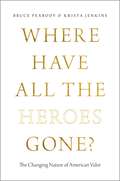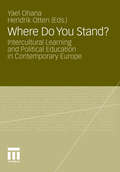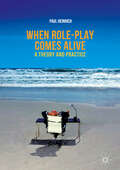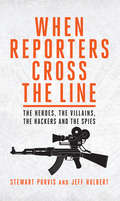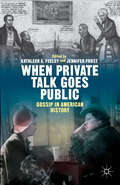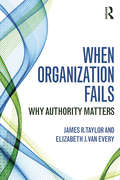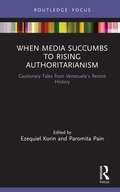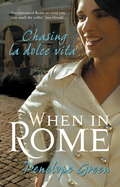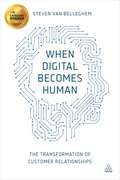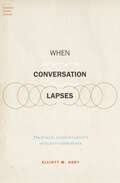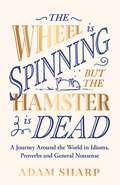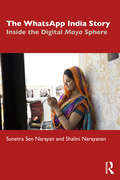- Table View
- List View
Where Ideas Go to Die: The Fate of Intellect in American Journalism
by Michael McDevittIdeas die at the hands of journalists. This is the controversial thesis offered by Michael McDevitt in a sweeping examination of anti-intellectualism in American journalism. A murky presence, anti-intellectualism is not acknowledged by reporters and editors. It is not easily measured by scholars, as it entails opportunities not taken, context not provided, ideas not examined. Where Ideas Go to Die will be the first book to document how journalism polices intellect at a time when thoughtful examination of our society's news media is arguably more important than ever. Through analysis of media encounters with dissent since 9/11, McDevitt argues that journalism engages in a form of social control, routinely suppressing ideas that might offend audiences. McDevitt is not arguing that journalists are consciously or purposely controlling ideas, but rather that resentment of intellectuals and suspicion of intellect are latent in journalism and that such sentiment manifests in the stories journalists choose to tell, or not to tell. In their commodification of knowledge, journalists will, for example, "clarify" ideas to distill deviance; dismiss nuance as untranslatable; and funnel productive ideas into static, partisan binaries. Anti-intellectualism is not unique to American media. Yet, McDevitt argues that it is intertwined with the nation's cultural history, and consequently baked into the professional training that occurs in classrooms and newsrooms. He offers both a critique of our nation's media system and a way forward, to a media landscape in which journalists recognize the prevalence of anti-intellectualism and take steps to avoid it, and in which journalism is considered an intellectual profession.
Where Ideas Go to Die: The Fate of Intellect in American Journalism
by Michael McDevittIdeas die at the hands of journalists. This is the controversial thesis offered by Michael McDevitt in a sweeping examination of anti-intellectualism in American journalism. A murky presence, anti-intellectualism is not acknowledged by reporters and editors. It is not easily measured by scholars, as it entails opportunities not taken, context not provided, ideas not examined. Where Ideas Go to Die will be the first book to document how journalism polices intellect at a time when thoughtful examination of our society's news media is arguably more important than ever. Through analysis of media encounters with dissent since 9/11, McDevitt argues that journalism engages in a form of social control, routinely suppressing ideas that might offend audiences. McDevitt is not arguing that journalists are consciously or purposely controlling ideas, but rather that resentment of intellectuals and suspicion of intellect are latent in journalism and that such sentiment manifests in the stories journalists choose to tell, or not to tell. In their commodification of knowledge, journalists will, for example, "clarify" ideas to distill deviance; dismiss nuance as untranslatable; and funnel productive ideas into static, partisan binaries. Anti-intellectualism is not unique to American media. Yet, McDevitt argues that it is intertwined with the nation's cultural history, and consequently baked into the professional training that occurs in classrooms and newsrooms. He offers both a critique of our nation's media system and a way forward, to a media landscape in which journalists recognize the prevalence of anti-intellectualism and take steps to avoid it, and in which journalism is considered an intellectual profession.
WHERE HAVE ALL THE HEROES GONE C: The Changing Nature of American Valor
by Bruce Peabody Krista JenkinsFrom the men and women associated with the American Revolution and Civil War to the seminal figures in the struggles for civil and women's rights, Americans have been fascinated with icons of great achievement, or at least reputation. But who spins today's narratives about American heroism, and to what end? In Where Have All the Heroes Gone?, Bruce Peabody and Krista Jenkins draw on the concept of the American hero to show an important gap between the views of political and media elites and the attitudes of the mass public. The authors contend that important changes over the past half century, including the increasing scope of new media and people's deepening political distrust, have drawn both politicians and producers of media content to the hero meme. However, popular reaction to this turn to heroism has been largely skeptical. As a result, the conversations and judgments of ordinary Americans, government officials, and media elites are often deeply divergent. Investigating the story of American heroes over the past five decades provides a narrative that can teach us about such issues as political socialization, institutional trust, and political communication.
Where Have All the Heroes Gone?: The Changing Nature of American Valor
by Bruce Peabody Krista JenkinsFrom the men and women associated with the American Revolution and Civil War to the seminal figures in the struggles for civil and women's rights, Americans have been fascinated with icons of great achievement, or at least reputation. But who spins today's narratives about American heroism, and to what end? In Where Have All the Heroes Gone?, Bruce Peabody and Krista Jenkins draw on the concept of the American hero to show an important gap between the views of political and media elites and the attitudes of the mass public. The authors contend that important changes over the past half century, including the increasing scope of new media and people's deepening political distrust, have drawn both politicians and producers of media content to the hero meme. However, popular reaction to this turn to heroism has been largely skeptical. As a result, the conversations and judgments of ordinary Americans, government officials, and media elites are often deeply divergent. Investigating the story of American heroes over the past five decades provides a narrative that can teach us about such issues as political socialization, institutional trust, and political communication.
Where Do You Stand?: Intercultural Learning and Political Education in Contemporary Europe
by Yael Ohana Hendrik OttenThis publication takes up the many and often controversial debates about the nature, content, methods and political significance of intercultural learning in and for the European youth field. Its starting point is the current depoliticisation of intercultural learning in this field, and especially in the programmes of the European Commission and the Directorate of Youth and Sport of the Council of Europe over the last several years. At the same time, the elevation of “intercultural dialogue” to panacea for all societal problems, from civil war to educational failure, is putting the mobilisational value of intercultural learning to the test.
When role-play comes alive: A Theory and Practice
by Paul HeinrichThis book harnesses the theory and practice of dramatic arts for the applied use in communication education. It introduces readers to educational role-play and how to use it, arguing that complete immersion is crucial to successful learning. Educational role-play sprang into life in many places including the medical world in the 1960s. Now, fifty years later, the field has grown exponentially across the world. Heinrich discusses how through role play interactions become more authentic, discussion becomes more focused and people take risks, and grow. Early chapters in Part I focus on theory, show how and why role-play works, and introduce the key performative factors of aesthetic distance, defamiliarization, framing, and focus that produce its dynamism. Chapters in Part II discuss how these ideas inform every aspect of role-play practice, offer practical guidance on designing and running scenarios, how to be more confident and mindful as player or facilitator, and provide a wide array of techniques to handle challenging situations. Most of the examples are drawn from medical communication, but the insights and techniques are equally applicable to other fields such as business, law, policing, and the military. The book will be of interest to educators, workplace trainers and managers, facilitators, role-play actors, and scholars interested in role-play performance.
When Robots Hug (Science and Fiction)
by James A. Crowder Alan C. CrowderBy 2027, it had been seven years since the scientists’ sea-changing research on artificial psychology and robotics. The work debuted around the same time as Large Language Model Chatbots, and the power of the integration of the two technologies put many industries in a tailspin. The commercial and defense industries especially were still scrambling to regulate their use in research and universities. The sought-after scientists signed with DARPA to build reliable and secure AI entities, but the agency grew fearful of the technology’s power and ultimately decided it was too dangerous to bring to market and demanded the scientists destroy the work. The researchers couldn’t bring themselves to discard 20 years of research, so instead sent the entities to various research labs around the world. But unbeknownst to them, each AI-entity embraced its new home, growing, adapting, evolving, and ultimately connecting beyond what the researchers could envision. In the end, asthe scientists catch up to each one, they realize the entities have discovered a very human means of interacting: the power of physical contact; and not physical contact between humans and technology, but physical contact between robotic entities. And with this discovery, the entities join forces to only grow stronger. This development ushers in a new paradigm where the difference between AI-entities and human entities becomes less and less discernible. All the AI and robotic science featured in the book is real; the story line is fictional, but with how fast innovation moves, it’s not hard to envision.
When Reporters Cross the Line: The Heroes, the Villains, the Hackers and the Spies
by Stewart Purvis Jeff HulbertWhen Reporters Cross the Line tells the true story of moments when the worlds of media, propaganda, politics, espionage and crime collide, casting journalism into controversy. Its pages feature some of the best-known names in British broadcasting, including John Simpson, Lindsey Hilsum and Charles Wheeler. There are men and women who went beyond recognised journalistic conventions. Some disregarded the code of their craft in the name of public interest; some crossed the line in ways that had truly shocking consequences. Many of the details have been kept as closely guarded secrets - until now. This unique account of modern reporting examines the lengths to which journalists on the front line are prepared to go to get a story or to espouse a cause. Journalistic heroes and villains abound, but certain of those heroes were flawed, and some of the villains were surprisingly principled. In the heat of war and political conflict, boundaries are ignored and ethics forgotten - and not just by opposing armies. In this extraordinary book, Stewart Purvis and Jeff Hulbert offer unparalleled access to the minds of reporters and to the often disturbing decisions they make when faced with extreme situations. In doing so, it hammers home some unpalatable truths, posing the fundamental question: where do you draw the line?
When Private Talk Goes Public: Gossip in American History
by Jennifer Frost Kathleen FeeleyGossip is one of the most common, and most condemned, forms of discourse in which we engage - even as it is often absorbing and socially significant, it is also widely denigrated. This volume examines fascinating moments in the history of gossip in America, from witchcraft trials to People magazine, helping us to see the subject with new eyes.
When Organization Fails: Why Authority Matters
by James R. Taylor Elizabeth J. Van EveryWhen Organization Fails: Why Authority Matters develops the study of authority as an area of investigation in organizational communication and management. As a research topic, authority has rarely been addressed in depth in the management and organizational communication literature. It is critical, however, to maintaining unity of purpose and action of the organization, and it is frequently cited by organizational members themselves. Utilizing two case studies, examined in depth and based on the accounts of the individuals involved, authors James R. Taylor and Elizabeth J. van Every explore the pathology of authority when it fails. They develop a theoretical foundation that aims to illuminate authority by positioning it in communication theory. This volume sets the stage for a new generation of scholars who can make their reputations as experts on authority, and is intended for scholars and graduate students in organizational communication, leadership, and discourse analysis. It also offers practical insights to consultants and management experts worldwide.
When Organization Fails: Why Authority Matters
by James R. Taylor Elizabeth J. Van EveryWhen Organization Fails: Why Authority Matters develops the study of authority as an area of investigation in organizational communication and management. As a research topic, authority has rarely been addressed in depth in the management and organizational communication literature. It is critical, however, to maintaining unity of purpose and action of the organization, and it is frequently cited by organizational members themselves. Utilizing two case studies, examined in depth and based on the accounts of the individuals involved, authors James R. Taylor and Elizabeth J. van Every explore the pathology of authority when it fails. They develop a theoretical foundation that aims to illuminate authority by positioning it in communication theory. This volume sets the stage for a new generation of scholars who can make their reputations as experts on authority, and is intended for scholars and graduate students in organizational communication, leadership, and discourse analysis. It also offers practical insights to consultants and management experts worldwide.
When Media Succumbs to Rising Authoritarianism: Cautionary Tales from Venezuela’s Recent History (Routledge Focus on Journalism Studies)
by Ezequiel Korin and Paromita PainThis book provides a transversal scholarly exploration of the multiple changes exhibited around Venezuelan media during the Chávez regime. Bringing together a body of original research by key scholars in the field, the book looks at the different processes entailed by Chavismo’s relationship with the media, extending their discussion beyond the boundaries of the specific cases or examples and into the entire articulation of a nearly-perfect communicational hegemony. It explores the wide-ranging transformations in the national mediascape, such as how censorship of journalistic endeavors has impacted news consumption/production in the country to the complexities of Venezuelan filmmaking during Chavismo, from the symbolic postmortem persistence of Chávez to the profound transformations undergone by telenovelas, from the politically induced migration of online audiences to the reinvention of media spaces for cultural journalism as forms of resistance. Allowing readers to engage not only with the particular case studies or exemplars presented, but with the underlying cultural, economic, political, societal, and technical aspects that come into play and which allow the extrapolation of this body of research onto other national or international contexts, this book will be an important resource for scholars and students of journalism, communication, media studies, and politics.
When Media Succumbs to Rising Authoritarianism: Cautionary Tales from Venezuela’s Recent History (Routledge Focus on Journalism Studies)
by Ezequiel Korin Paromita PainThis book provides a transversal scholarly exploration of the multiple changes exhibited around Venezuelan media during the Chávez regime. Bringing together a body of original research by key scholars in the field, the book looks at the different processes entailed by Chavismo’s relationship with the media, extending their discussion beyond the boundaries of the specific cases or examples and into the entire articulation of a nearly-perfect communicational hegemony. It explores the wide-ranging transformations in the national mediascape, such as how censorship of journalistic endeavors has impacted news consumption/production in the country to the complexities of Venezuelan filmmaking during Chavismo, from the symbolic postmortem persistence of Chávez to the profound transformations undergone by telenovelas, from the politically induced migration of online audiences to the reinvention of media spaces for cultural journalism as forms of resistance. Allowing readers to engage not only with the particular case studies or exemplars presented, but with the underlying cultural, economic, political, societal, and technical aspects that come into play and which allow the extrapolation of this body of research onto other national or international contexts, this book will be an important resource for scholars and students of journalism, communication, media studies, and politics.
When in Rome: Chasing la dolce vita
by Penelope GreenThe first book in a much loved Italian travel memoir trilogy which also includes the delightful See Naples and Die and Girl by Sea.Winner of the Grollo Ruzzene Foundation Prize in the Victorian Premier's Literary Awards.We've all dreamed of a new exotic life in a European city, but who actually goes? When in Rome shows what can happen when you are courageous - and perhaps crazy - enough to chase this dream. With her thirtieth birthday on the horizon and her safe and comfortable life in Sydney outside her front door, Penelope Green decided it was now or never. Undaunted by the fact she spoke absolutely no Italian, had no job, no friends and nowhere to live, and armed only with an Italian English dictionary, irresistible optimism and a fair dash of bravery, she was determined to carve out her own slice of la dolce vita.Both frank and funny, Penny tells how she plunged into the deep end of Roman life from her first giddy Vespa ride to daily struggles with the language and culture (not to mention a few lecherous locals), to seeing in her birthday with a kiss from her lover under the floodlit Colosseum. 'Written engagingly and with great honesty, Penelope Green's experiences definitely do not include restoring any farmhouses... Funny and full of heart' - The Australian Women's Weekly'Descriptions of Rome so vivid you can smell the coffee' - Sun-HeraldAuthor BiographyPenelope Green was born in Sydney and worked as a print journalist around Australia for a decade before moving to Rome in 2002. Her first book, When in Rome, recounts her early experiences in the Eternal City. In 2005 she moved to Naples to work for ANSAmed, a Mediterranean news service. She found an apartment in the city's colourful Spanish Quarter, worked hard at mastering the Neapolitan dialect, and writing her second travel memoir, See Naples and Die. Girl by Sea completes Penny's Italian experience as she moves to the idyllic island of Procida, across the bay from Capri, with her Italian partner, Alfonso. The couple have now returned to Australia, where they are making a new life for themselves back in the Southern hemisphere. For more information visit penelopegreen.com.au
When Eero Met His Match: Aline Louchheim Saarinen and the Making of an Architect
by Eva HagbergA uniquely personal biographical account of Louchheim’s life and work that takes readers inside the rarified world of architecture mediaAline B. Louchheim (1914–1972) was an art critic on assignment for the New York Times in 1953 when she first met the Finnish-American architect Eero Saarinen. She would become his wife and the driving force behind his rise to critical prominence. When Eero Met His Match draws on the couple’s personal correspondence to reconstruct the early days of their thrilling courtship and traces Louchheim’s gradual takeover of Saarinen’s public narrative in the 1950s, the decade when his career soared to unprecedented heights.Drawing on her own experiences as an architecture journalist on the receiving end of press pitches and then as a secret publicist for high-end architects, Eva Hagberg paints an unforgettable portrait of Louchheim while revealing the inner workings of a media world that has always relied on secrecy, friendship, and the exchange of favors. She describes how Louchheim codified the practices of architectural publicity that have become widely adopted today, and shows how, without Louchheim as his wife and publicist, Saarinen’s work would not have been nearly as well known.Providing a new understanding of postwar architectural history in the United States, When Eero Met His Match is both a poignant love story and a superb biographical study that challenges us to reconsider the relationship between fame and media representation, and the ways the narratives of others can become our own.
When Eero Met His Match: Aline Louchheim Saarinen and the Making of an Architect
by Eva HagbergA uniquely personal biographical account of Louchheim’s life and work that takes readers inside the rarified world of architecture mediaAline B. Louchheim (1914–1972) was an art critic on assignment for the New York Times in 1953 when she first met the Finnish-American architect Eero Saarinen. She would become his wife and the driving force behind his rise to critical prominence. When Eero Met His Match draws on the couple’s personal correspondence to reconstruct the early days of their thrilling courtship and traces Louchheim’s gradual takeover of Saarinen’s public narrative in the 1950s, the decade when his career soared to unprecedented heights.Drawing on her own experiences as an architecture journalist on the receiving end of press pitches and then as a secret publicist for high-end architects, Eva Hagberg paints an unforgettable portrait of Louchheim while revealing the inner workings of a media world that has always relied on secrecy, friendship, and the exchange of favors. She describes how Louchheim codified the practices of architectural publicity that have become widely adopted today, and shows how, without Louchheim as his wife and publicist, Saarinen’s work would not have been nearly as well known.Providing a new understanding of postwar architectural history in the United States, When Eero Met His Match is both a poignant love story and a superb biographical study that challenges us to reconsider the relationship between fame and media representation, and the ways the narratives of others can become our own.
When Digital Becomes Human: The Transformation of Customer Relationships
by Steven Van BelleghemWINNER: 2016 Chartered Management Institute Management Book of the Year - Commuter's Read CategoryIn an age when customers have access to vast amounts of data about a company, its product and its competitors, customer experience becomes increasingly important as a sustainable source of competitive advantage. But success doesn't just rely on digital engagement and excellence, but also on combining a digital-first attitude with a human touch. In When Digital Becomes Human, Steven Van Belleghem explores and explains the new digital relationships. Packed with global examples from organizations that have successfully transformed their customer relationships, such as Amazon, Toyota, ING, Coolblue, Nike and Starbucks, When Digital Becomes Human presents a clear model that companies can easily implement to integrate an emotional layer into their digital strategy. This guide to combining two of a business's most important assets - its people and its digital strengths - covers the latest issues in digital marketing and customer experience management, including omnichannel and multichannel experiences, big data and predictive analytics, privacy concerns, customer collaboration (ie crowdsourcing) and more.
When Digital Becomes Human: The Transformation of Customer Relationships
by Steven Van BelleghemWINNER: 2016 Chartered Management Institute Management Book of the Year - Commuter's Read CategoryIn an age when customers have access to vast amounts of data about a company, its product and its competitors, customer experience becomes increasingly important as a sustainable source of competitive advantage. But success doesn't just rely on digital engagement and excellence, but also on combining a digital-first attitude with a human touch. In When Digital Becomes Human, Steven Van Belleghem explores and explains the new digital relationships. Packed with global examples from organizations that have successfully transformed their customer relationships, such as Amazon, Toyota, ING, Coolblue, Nike and Starbucks, When Digital Becomes Human presents a clear model that companies can easily implement to integrate an emotional layer into their digital strategy. This guide to combining two of a business's most important assets - its people and its digital strengths - covers the latest issues in digital marketing and customer experience management, including omnichannel and multichannel experiences, big data and predictive analytics, privacy concerns, customer collaboration (ie crowdsourcing) and more.
When Conversation Lapses: The Public Accountability of Silent Copresence (Foundations of Human Interaction)
by Elliott M. HoeySilence takes on meaning based on the contexts of its occurrence. This is especially true in social interactions: consider the difference between silence after "lemme think," and silence after "will you marry me?" This book examines a particular form of silence, the conversational lapse. These regularly appear in conversations when all interactants pass up the opportunity to speak, and are moments when talk seems to falter or give way to matters extraneous to the conversation. What are these silences for the participants who, by virtue of not speaking, allowed them to develop? Elliott M. Hoey here offers the first in-depth analysis of lapses in conversation. Using methods from Conversation Analysis, the author explores hundreds of lapses in naturally occurring social occasions with each chapter focusing on a different aspect of how participants produce and locate order in lapses. Particular emphasis is given to how lapses emerge, what people do during the silence, and how they restart conversation afterwards. This research uncovers participants' methods for organizing lapses in their everyday affairs such that those silences are rendered as understandable periods of non-talk. By articulating participants' understandings of when and where talk is relevant, necessary, or appropriate, the research brings into focus the borderlines between talk-in-interaction and other realms of social life. This book shows lapses to be a particular and fascinating kind of silence with unique relevancies for the social situations of which they are a part.
When Conversation Lapses: The Public Accountability of Silent Copresence (Foundations of Human Interaction)
by Elliott M. HoeySilence takes on meaning based on the contexts of its occurrence. This is especially true in social interactions: consider the difference between silence after "lemme think," and silence after "will you marry me?" This book examines a particular form of silence, the conversational lapse. These regularly appear in conversations when all interactants pass up the opportunity to speak, and are moments when talk seems to falter or give way to matters extraneous to the conversation. What are these silences for the participants who, by virtue of not speaking, allowed them to develop? Elliott M. Hoey here offers the first in-depth analysis of lapses in conversation. Using methods from Conversation Analysis, the author explores hundreds of lapses in naturally occurring social occasions with each chapter focusing on a different aspect of how participants produce and locate order in lapses. Particular emphasis is given to how lapses emerge, what people do during the silence, and how they restart conversation afterwards. This research uncovers participants' methods for organizing lapses in their everyday affairs such that those silences are rendered as understandable periods of non-talk. By articulating participants' understandings of when and where talk is relevant, necessary, or appropriate, the research brings into focus the borderlines between talk-in-interaction and other realms of social life. This book shows lapses to be a particular and fascinating kind of silence with unique relevancies for the social situations of which they are a part.
When Buyers Say No: Essential Strategies for Keeping a Sale Moving Forward
by Tom Hopkins Ben KattThis is a complete and practical guide which highlights the authors' new strategic approaches to selling when the buyer initially declines or is resistant on a sales opportunity. Hopkins and Katt explain that most sales reps take a traditional linear approach to selling, but that the trick in closing is in taking a more creative and circular approach. That's the key.It all starts with how the buyer initially says, "No." Too many sales reps don't pay close attention as to how that's presented. Hopkins and Katt point out that "no" may suggest all sorts of other options -- avenues that can eventually lead to the buyer actually saying yes.The authors introduce a novel concept called the Circle of Persuasion which offers sales reps a new approach in this potentially tricky process. Along the way, WHEN BUYERS SAY NO details prescriptive steps and even sample dialogues that will instruct and guide sales professionals on how to best cultivate buyer-seller relationships. There's particular emphasis on how to establish the kind of rapport that ultimately leads to a successful close.
When Buyers Say No: Essential Strategies for Keeping a Sale Moving Forward
by Tom Hopkins Ben KattThis is a complete and practical guide which highlights the authors' new strategic approaches to selling when the buyer initially declines or is resistant on a sales opportunity. Hopkins and Katt explain that most sales reps take a traditional linear approach to selling, but that the trick in closing is in taking a more creative and circular approach. That's the key. It all starts with how the buyer initially says, "No." Too many sales reps don't pay close attention as to how that's presented. Hopkins and Katt point out that "no" may suggest all sorts of other options -- avenues that can eventually lead to the buyer actually saying yes. The authors introduce a novel concept called the Circle of Persuasion which offers sales reps a new approach in this potentially tricky process. Along the way, WHEN BUYERS SAY NO details prescriptive steps and even sample dialogues that will instruct and guide sales professionals on how to best cultivate buyer-seller relationships. There's particular emphasis on how to establish the kind of rapport that ultimately leads to a successful close.
The Wheel is Spinning but the Hamster is Dead: A Journey Around the World in Idioms, Proverbs and General Nonsense
by Adam SharpKnow your tater trap from your sniffle herring in Sharp's journey around the world in idioms, proverbs and general nonsense - the perfect gift for Christmas'Brilliant, hilarious fun from a master wordsmith - you will LOVE this book' Kit de Waal'Extremely entertaining and very useful for new insults' Russell Kane'Utter genius' Marian Keyes'Brilliant' Brian BilstonJoin wordsmith Adam Sharp as he journeys around the world in idioms, proverbs and general nonsense. Learn unusual insults from France (You are a potato with the face of a guinea pig), how to hurry someone up in the US (You're going as slow as molasses in January) and what they call a shark in Vietnam (fat fish).Full of fascinating, ridiculous and hilarious translations from around the world, Adam has rounded up the very best of what every corner of the globe has to offer.Let's get this show on the road! Or:Let's saddle the chickens! (German)On with the butter! (Icelandic)Forward with the goat! (Dutch)
The WhatsApp India Story: Inside the Digital Maya Sphere
by Sunetra Sen Narayan Shalini NarayananWhatsApp is used by over half a billion people in India today in all fields – in business, corporate and informal sectors, in government, for education and among friends, families and acquaintances. This book critically explores the social messaging app’s rapid expansion in India and its growing influence and looks at whether, as a form of horizontal communication, it poses a challenge to more traditional structures of communication. The book examines WhatsApp’s spread in the personal and professional lives of Indians and the myriad ways in which people in India are using the app in social and business interactions, including among people living with disabilities. Using case studies, interviews, surveys and in-depth research, it analyses key aspects of WhatsApp’s massive popularity and its impact on how people communicate. It also explores its impact on the psycho-social dynamics in India, including the dissemination of fake news and politically motivated content, and the consequent need for media regulation in the country. One of the first books to analyse the pervasiveness of WhatsApp and social media apps in different areas of Indian society, this book will be of interest to scholars and students of media studies, communication studies, digital media, cultural studies, cyberculture studies, sociology and social policy and media law.
The WhatsApp India Story: Inside the Digital Maya Sphere
by Sunetra Sen Narayan Shalini NarayananWhatsApp is used by over half a billion people in India today in all fields – in business, corporate and informal sectors, in government, for education and among friends, families and acquaintances. This book critically explores the social messaging app’s rapid expansion in India and its growing influence and looks at whether, as a form of horizontal communication, it poses a challenge to more traditional structures of communication. The book examines WhatsApp’s spread in the personal and professional lives of Indians and the myriad ways in which people in India are using the app in social and business interactions, including among people living with disabilities. Using case studies, interviews, surveys and in-depth research, it analyses key aspects of WhatsApp’s massive popularity and its impact on how people communicate. It also explores its impact on the psycho-social dynamics in India, including the dissemination of fake news and politically motivated content, and the consequent need for media regulation in the country. One of the first books to analyse the pervasiveness of WhatsApp and social media apps in different areas of Indian society, this book will be of interest to scholars and students of media studies, communication studies, digital media, cultural studies, cyberculture studies, sociology and social policy and media law.

